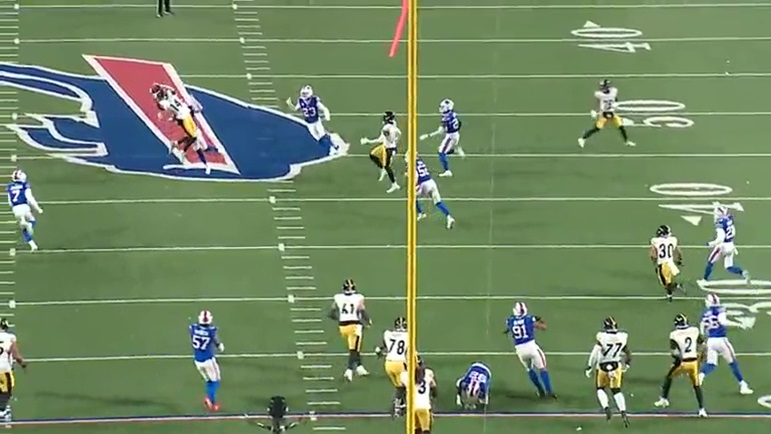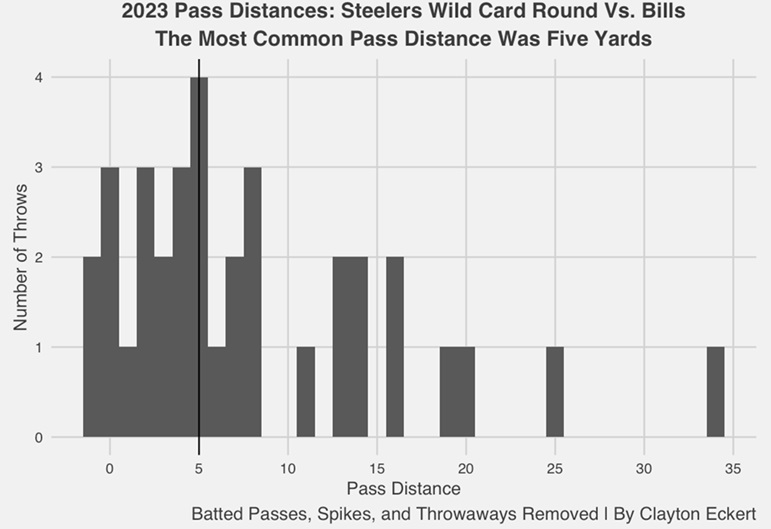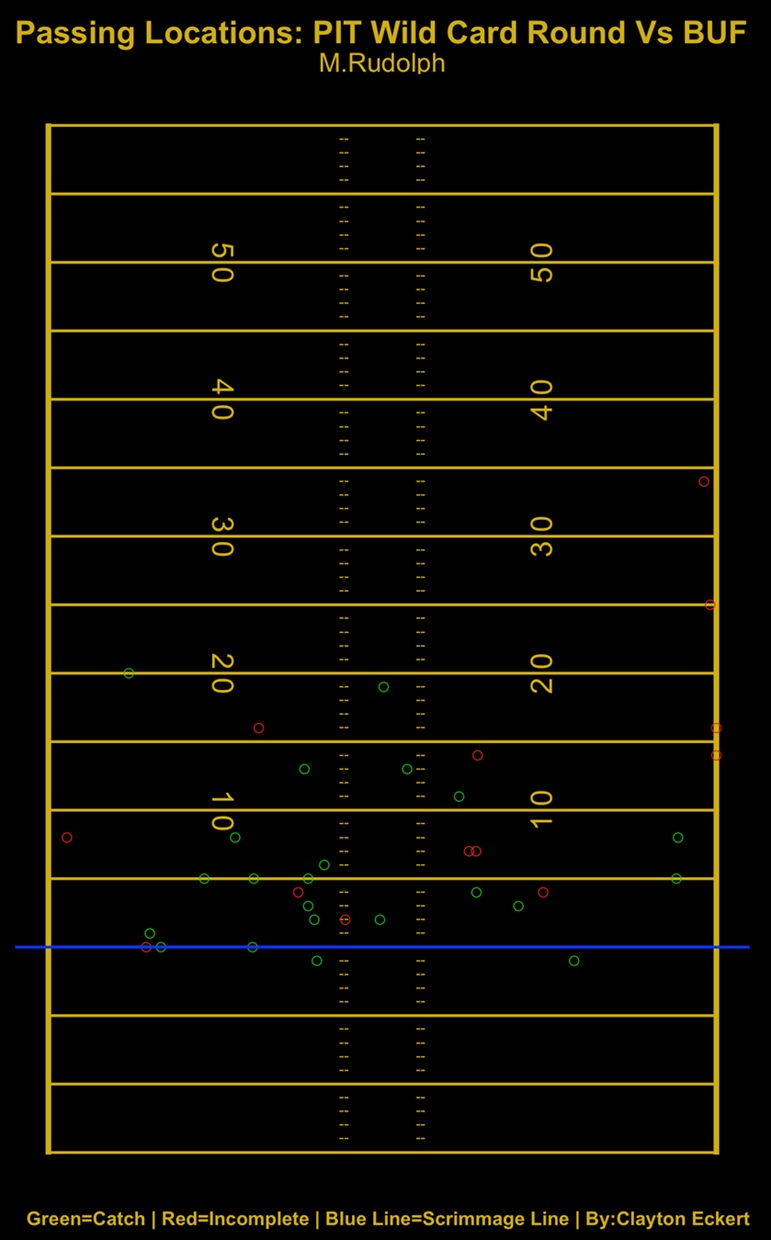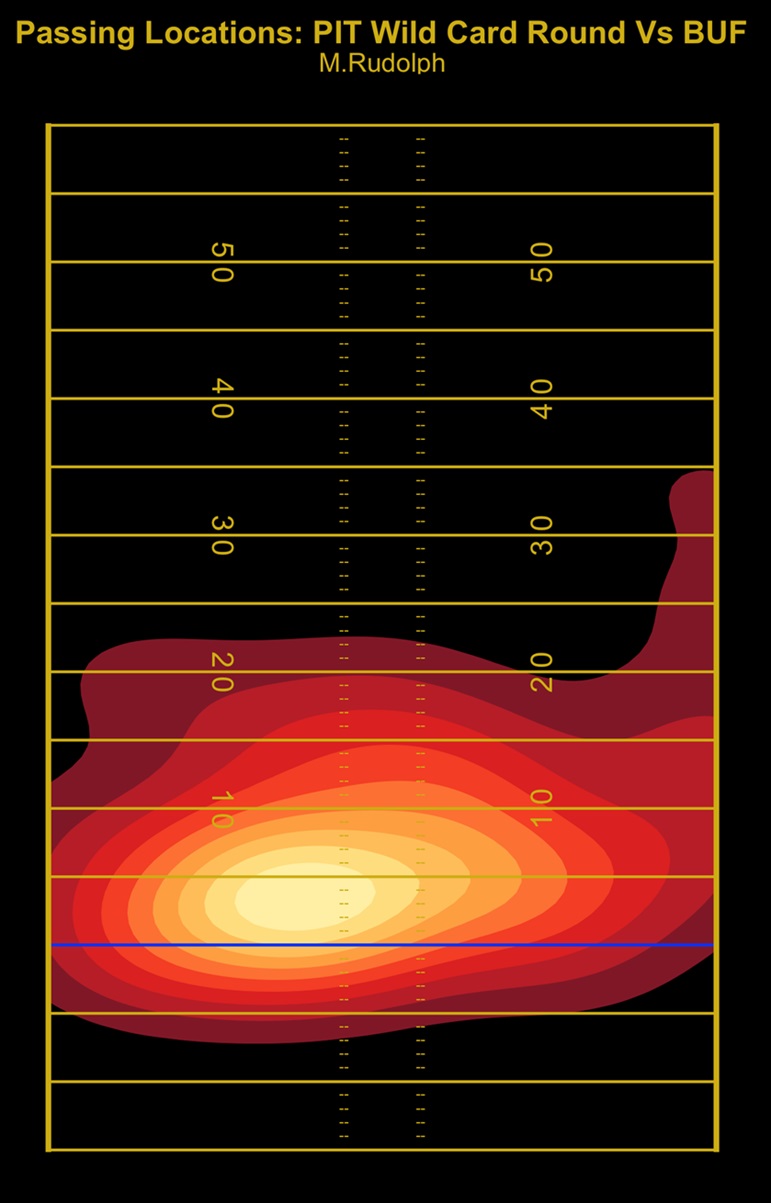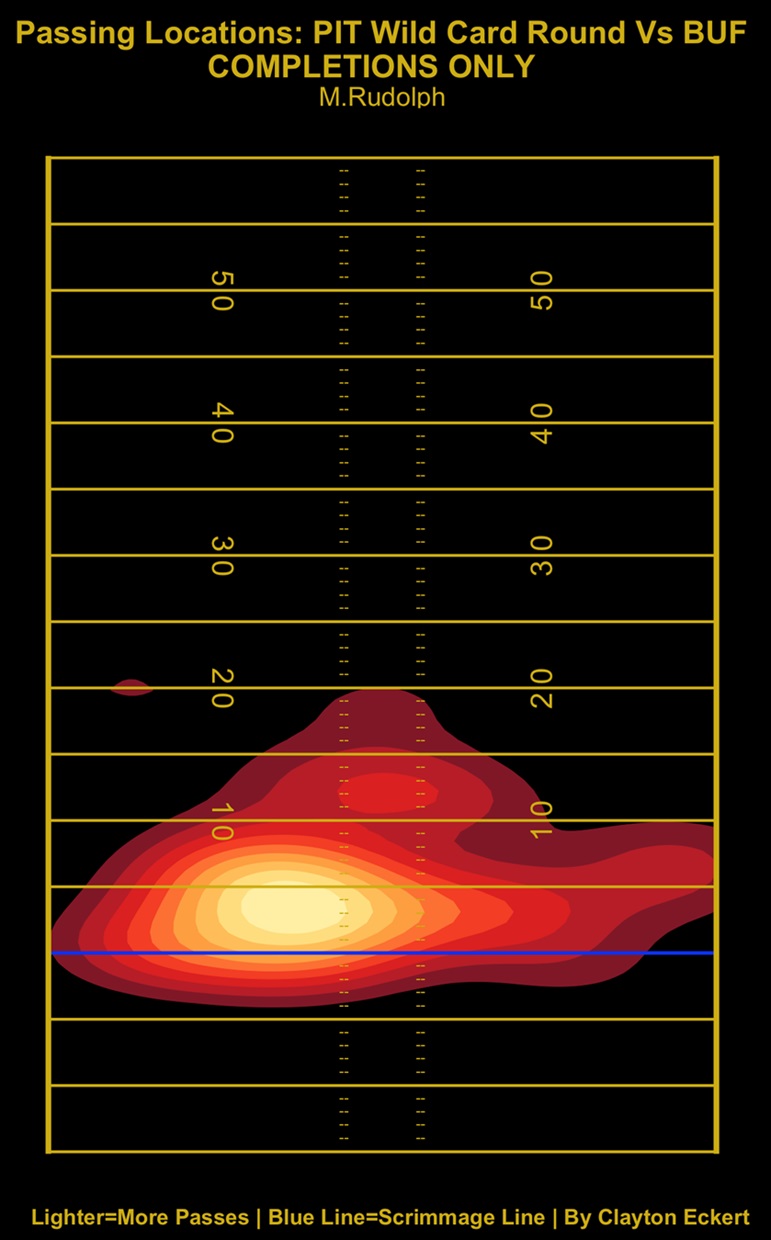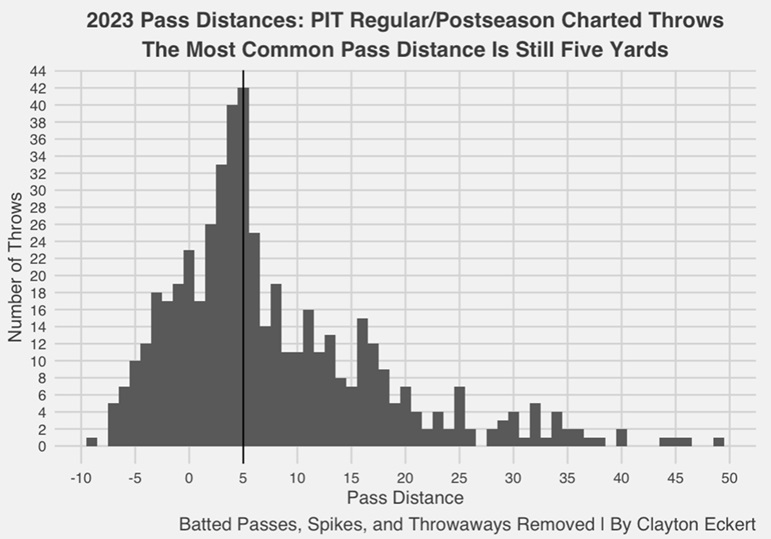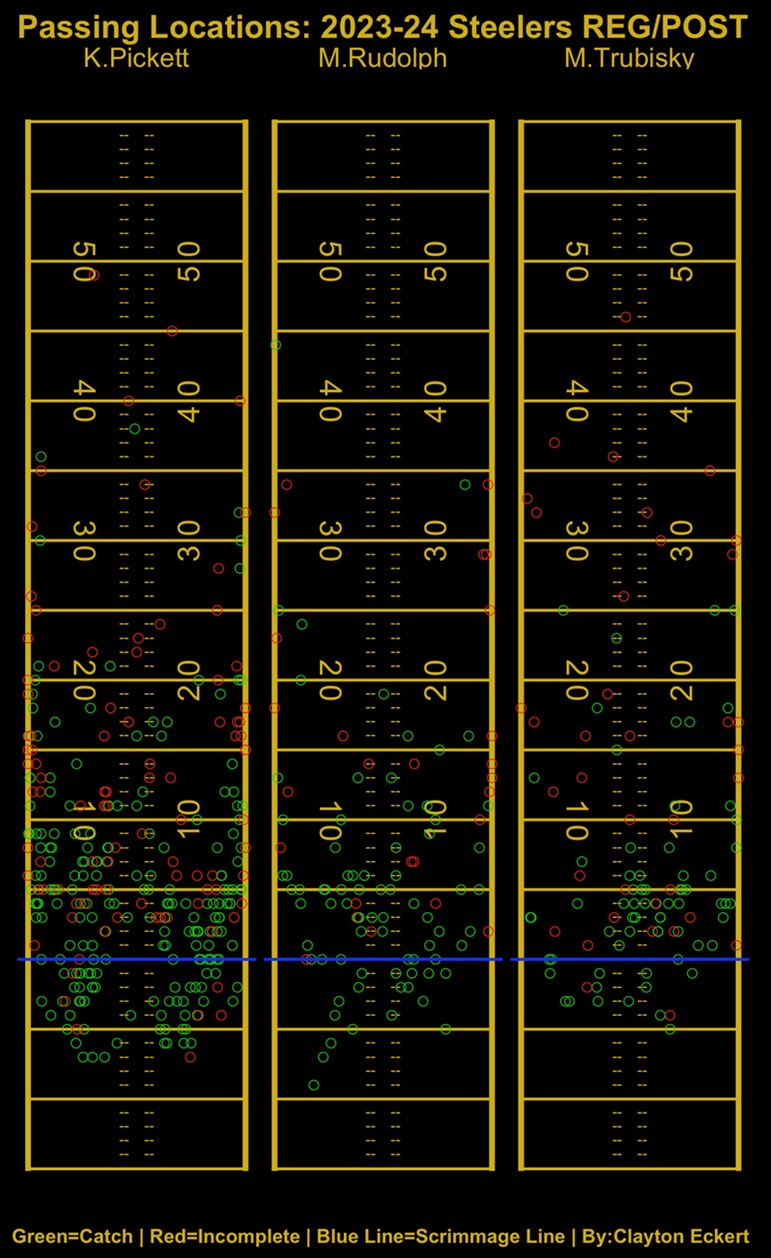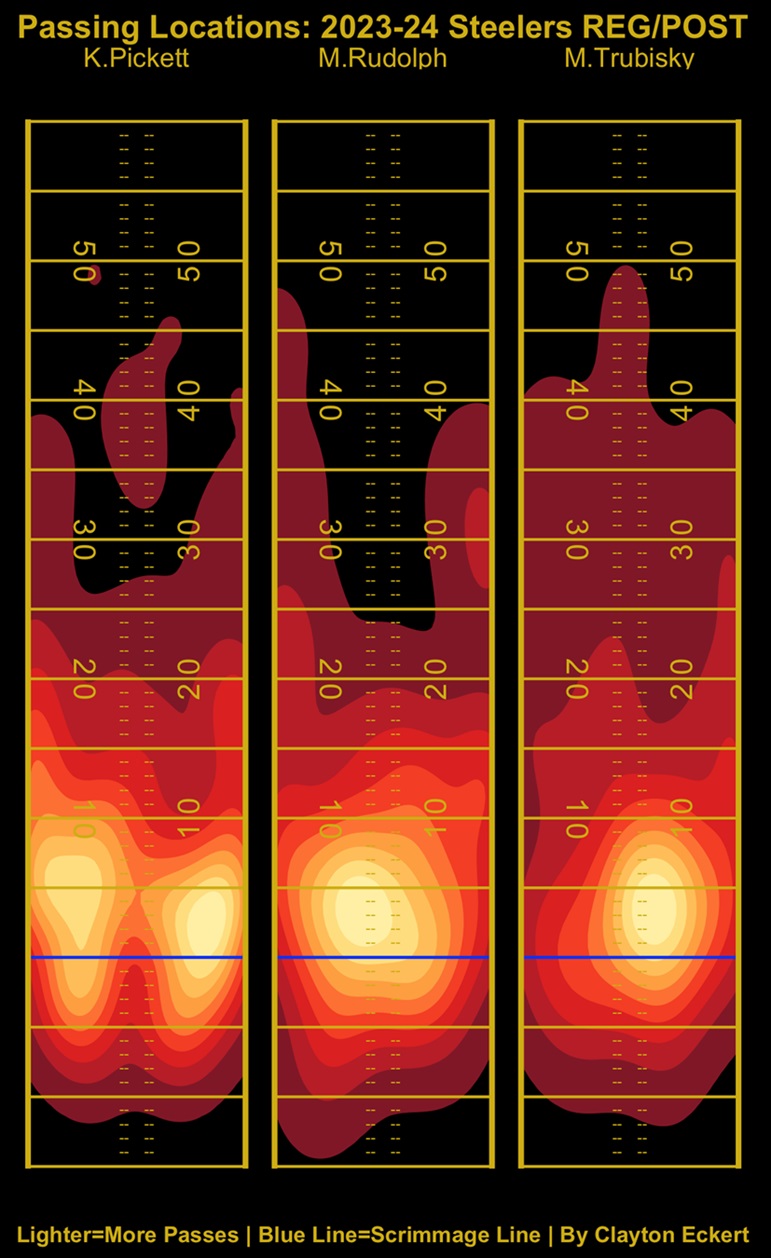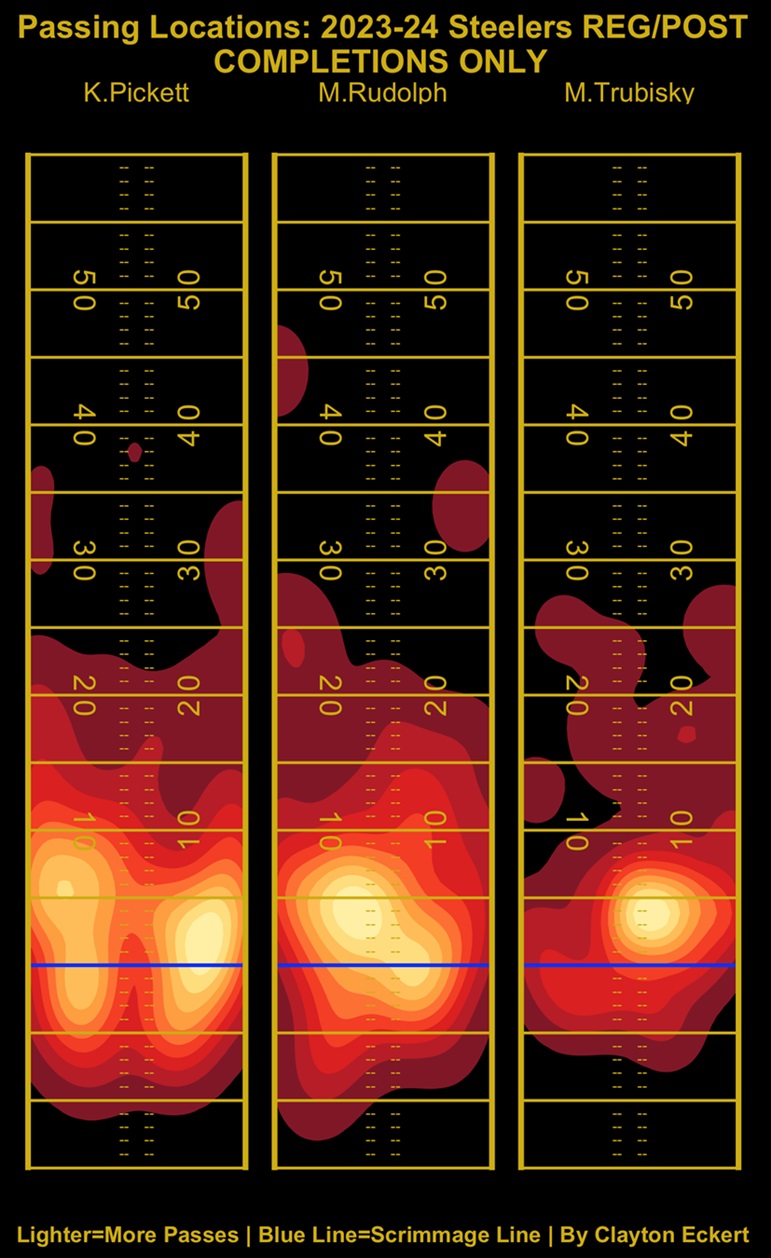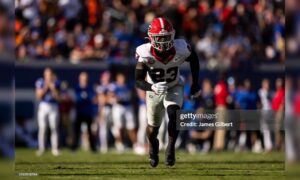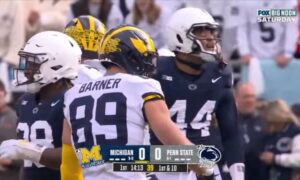The Pittsburgh Steelers thankfully reached the postseason, but all too familiarly were bounced in the Wild Card Round. Unable to lean on the running game with early turnovers, the Buffalo Bills capitalized and Pittsburgh dug themselves 21-0 hole that proved insurmountable in an agonizing 31-17 loss.
For the second season, I am charting, visualizing, and providing takeaways for the all-important quarterback position for the Pittsburgh Steelers.
Couple notes. Thanks to Thomas Mock for his great work that helped me learn much of what I’m using visually. Spikes and clear throwaways are removed due to being the correct situational decision, along with batted passes at the line of scrimmage that effect the intended pass location. This week, four passes were removed: two bats, a throwaway, and a spike.
First career playoff start for QB Mason Rudolph, and fourth QB1 opportunity of the 2023-24 season. On the stat sheet, he went 22-of-39 (56.4-percent), his lowest completion rate of the campaign. Huge difference was locking on to receivers particularly early, as opposed to working through progressions, which he did very well previously.
Buffalo’s defense deserves credit, limiting the running game (75 RB yards), 18 pressures on Rudolph (most in 2023-24), and were aggressive ball hunters with a sack (T Broderick Jones), bats/pass breakups, and got a critical red zone interception as well. The latter was a hope I had for Pittsburgh’s defense, who led the NFL this season.
Rudolph finished with 229 passing yards, two touchdowns, an 80.0 rating, and only one explosive play despite trailing the entire game. The latter can’t happen in the playoffs against such an explosive team, especially with the game rescheduled from blizzard conditions.
Pittsburgh was able to eek back and cut the lead to seven in the fourth quarter, but the glimmer of hope turned to nope, with Buffalo answering quickly for the win.
Let’s examine the 35 charted-passes further, with number of throws at each pass distance for the game:
#1. 0-5 air-yards: 45.7-percent. Very high rate here. First pass of the game was play-action screen to RB Jaylen Warren, catching at the line with great YAC for 16 yards, with a great block in front from G Isaac Seumalo. Another refreshing success late first quarter, wide open dump-off to WR Allen Robinson II at the line for 13 yards to the sideline.
Then on third and nine, Rudolph eluded pressure and found TE Pat Freiermuth wide open in the flat, trucking the DB angrily with great YAC again for 12 yards and the only conversion of the first half (1-of-5).
Mid-second quarter, Rudolph play-action/rolled left, pumping against a free rusher, then floating to TE Darnell Washington in the flat, but too low for the big body to corral. The following third and seven, C Mason Cole was beat bad allowing the QB hit, causing the incompletion.
Another third and seven in the fourth quarter, WR Diontae Johnson sat underneath deeper routes open, catching the four air-yard target with a nice cut/YAC for a huge 8-yard conversion, key to the final touchdown drive and smallest deficit. Also, five throws came in garbage time.
#2. 5-10 air-yards: 28.6-percent. Painful first example, an open stop route to WR George Pickens, gaining eight but coughing up the fumble turnover, and Buffalo needing just one play to put up their ensuing touchdown. Gut-wrenching. Third and nine the following drive, a LB pass breakup (Pickens), unable to corral it.
Most egregious forced throw was the interception, locking on to Johnson from empty set in the red zone, a frustrating alignment at the 4-yard line even with rushing issues, and the DB undercutting the comeback on the sideline.
Two-minute warning before halftime, two consecutive Pickens targets. First and ten was a sit route, Rudolph getting it out for five yards to the red zone, tackled quickly. Second and five was an out route, running out of bounds for another five yards and a fresh set of downs.
This set up the first much-needed touchdown, a great design with Rudolph working through progressions to find Johnson, separating on the slant making the score look easy. Following a second false start penalty on Washington, a third quarter stop route to Freiermuth at five air-yards featured more tough running, churning for nine yards.
Then after a Rudolph chain moving six-yard scramble, he found Johnson from empty, who provided nice YAC again for 11 yards. This was the aforementioned second touchdown drive, another great concept using trips bunch, working WR Calvin Austin III open on the quick slant for the seven-yard score. Creative schemes equal best results.
A late effort fourth and three was an understandably frustrating fail, a debatable DPI on Pickens that sealed the unfortunate deal.
#3. 10-15 air-yards: 14.3-percent.
Third quarter started poorly with Washington’s first false start penalty. They overcame it, a play-action post route to Johnson over the middle with good separation and YAC for 19 yards.
Following play was another struggled Pickens connection example (5-of-10), this one slipping along the sideline on the throw under pressure that luckily wasn’t intercepted. Third-straight pass at this distance, pressured again getting off the second and ten post route to Pickens for 13 yards.
Closing the drive near the red zone on third and nine, Rudolph goes jump ball to Pickens despite the bracket (Cole pressure), broken up and leading to a disappointing field goal settle (21-10).
#4. 15-20 air-yards: 11.4-percent. On the first drive, Rudolph overthrew Freiermuth on a corner route out of bounds, despite good coverage on the first third down fail of the game.
Late third quarter, Rudolph threw incomplete to Freiermuth. This resulted in third and 11, a wow body-control contested catch by Pickens over the middle, despite the extended play throw behind him for the 19-yard conversion.
#5. Explosive: 8.6-percent. Late first quarter, a play-action corner route to Freiermuth, wide open at 20 air-yards and great YAC for 33, but ends in a second early fumble that luckily ruled out on the defensive recovery.
Fourth quarter in the red area, Rudolph locks on to Pickens in the end zone despite good coverage, missing Johnson wide open on the slot go on the same side, a would-be easy score. Last example, final prayer, well underthrown at 34 air-yards.
#6. Behind-the-Line: 5.7-percent. Least common after topping the list last game. Two throws, one a dump to Robinson, taking a big hit that he was unable to return from (concussion). The other a late third and three to Warren (Jones pressure), but only reached the line of scrimmage, and followed up by the aforementioned fourth down fail.
Here are the dots of completions/incompletions for the game:
Similar story was lots of short passing. Rudolph threw on/between the numbers more, 22-of-35 charted throws (62.9-percent of throws), completing 15 (68.2 percent-rate). Outside the numbers, particularly to the right ten-plus air-yards were painful, going 0-for-four.
Now for the heat-maps for charted-passes, then completions only:
The charts illustrate the conservative pass distances, especially considering the game script. Had some intermediate success over the middle, and longest was a 20 air-yard completion (Freiermuth fumble). Favored the left outside the hash at six-or-less yards, going 7-of-9 (77.8-percent).
Now, here’s all 506 charted throws of 2023-24 regular and post-season, with frequencies by distance and previous averages:
#1. 0-5 air-yards: Season 35.8-percent. Previously 35.0-percent.
#2. 5-10 air-yards: Season 24.1-percent. Previously 23.8-percent.
#3. Behind-the-line: Season 17.6-percent. Previously 18.5-percent.
#4. 10-15 air-yards: Season 13.0-percent. Previously 13.0-percent.
#5. Explosive: Season 11.9-percent. Previously 12.1-percent.
#6. 15-20 air-yards: Season 10.9-percent. Previously 10.8-percent.
Ten yards or less notably up-ticked, while the rest declined or stood pat.
Here are dots for 2023 regular and postseason charted throws, along with completion rates by distance:
PICKETT:
Behind-the-line: Season 51/58 (87.9-percent).
0-5 air-yards: Season 75/99 (75.8-percent).
5-10 air-yards: Season 52/75 (69.3-percent).
10-15 air-yards: Season 19/38 (50-percent).
15-20 air-yards: Season 15/34 (44.1-percent).
Explosive: Season 12/33 (36.4-percent).
Season Total: 224/337 (66.5-percent).
TRUBISKY:
Behind-the-line: Season 12/14 (85.7-percent).
0-5 air-yards: Season 34/44 (77.3-percent).
5-10 air-yards: Season 15/20 (75-percent).
10-15 air-yards: Season 4/10 (40-percent).
15-20 air-yards: Season 5/13 (38.5-percent).
Explosive: Season 4/15 (26.7-percent).
Season Total: 74/116 (63.8-percent).
RUDOLPH:
Behind-the-line: Season 16/16 (100-percent). Previously 14/14 (100-percent).
0-5 air-yards: Season 32/38 (84.2-percent). Previously 20/22 (90.9-percent).
5-10 air-yards: Season 22/26 (84.6-percent). Previously 15/16 (93.8-percent).
10-15 air-yards: Season 10/17 (58.8-percent). Previously 7/12 (58.3-percent).
15-20 air-yards: Season 5/8 (62.5-percent). Previously 3/4 (75-percent).
Explosive: Season 5/12 (41.7-percent). Previously 4/9 (44.4-percent).
Season Total: Season 77/103 (74.8).
Every rate but behind the line dropped in the Wild Card round for Rudolph, but still closes 2023-24 with the best rates across the board.
To close, here are heat maps for all charted passes, then completions only:
CAVEAT: The sample sizes are still quite different for the three QBs, with Rudolph and Trubisky’s maps generously with low opportunities comparatively. Trubisky’s longest air-yard completion was 25 yards (three times), while Rudolph’s longest 44 air-yard completion got a wider map than Pickett’s 38 air-yarder over the middle due to the sample sizes.
Some encouraging things to close the year, but consistent creativity and scheme are high on the hopeful radar for the 2024 offense. The two touchdowns this game were prime examples, and did look to the middle of the field more often, but still too dink and dunk with their deficit on the biggest of stages. Insanity. They can’t continue the same things expecting a different result, and can hopefully end the postseason drought since 2016 in 2024.

